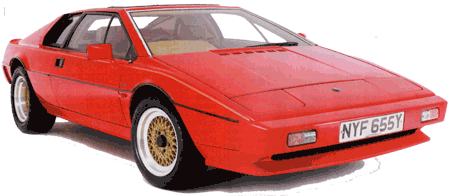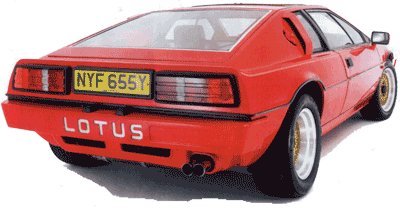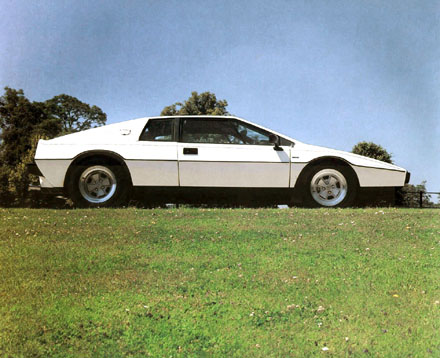

Treat yourself to a Lotus
The Esprit's reputation for delivering a great
driving experience is justified,
but its reputation for being fragile is undeserved
Lotus Esprit:
1976-1988
by Richard Dredge, photos: Tom Wood
Practical
Classics
December 2004
As soon as the Esprit made its debut in 1976, its was destined
for stardom. How could such a dramatically styled car fail to
make an impact, even if its performance was initially not quite
what Lotus claimed? It may not have been as quick as a Porsche
911 or Ferrari 308 but they cost thousands of pounds more to buy.
Nearly three decades after the Esprit first went on sale, the news is just as good. It still handles brilliantly and it's still very quick but best of all, it's still affordable as ever. Even the reliability issues have largely been sorted, which all adds up to a car that gives you more bangs per buck then you can get pretty much anywhere else.
The first cars were delivered in 1976, and while the 'Lotus Of Trouble, Usually Serious' Tag bestowed on Lotus is unjustified on its latest cars, when the first Esprits were being delivered to customers it was apt. Those first cars were especially fragile, with rot-prone chassis and suspension that tended to wear quickly. It was the same for the Series 2. When the Series 3 arrived in 1981, things were looking much better, but the most interesting Esprit appeared the year before. This was the Turbo, in limited edition Essex guise, of which just 57 were made, Lotus then reduced the specification and re-launched the Turbo as a standard production model in 1981, but the one to go for is the run-out Turbo HC of 1986. It's stronger, faster and better built than all its predecessors, but it's also hard to find because of its rarity. Then again, no one version of the Esprit is especially plentiful, so whichever one you opt for, the key is to have a good look around before parting with you cash.
BODYWORK
The Esprit's bodyshell is strong, durable and heavy, thanks to
Lotus's Vacuum Assisted Resin Injection (VARI) production process.
Corrosion, cracking and crazing (many small cracks visible in
the paints surface) don't usually need to be considered, although
they are possible – as is accident damage.
The first area to check is the nose, which suffers from stone chipping. Hopefully any damage will be confined to unsightly paint only but in some cases the plastic itself may be harmed. The whole bodyshell then needs to be checked for star cracks in the glassfibre, resulting from the bodywork having been hit by objects such as stones.
More serious is poorly repaired accident damage, especially where glassfibre hasn't been let in properly. The most likely areas for such wounds are the car's corners, although parking scrapes could lead to scars anywhere. Look for paint that has sunk. It will appear mottled where some of the pigment has remained on the surface while the rest has sunk into the plastic. It's possible to invisibly mend damaged glassfibre, but it's a skilled job that isn't attempted lightly. If scars are evident get an estimate of what a specialist will charge to put it right, if it's not something you can fix yourself. If there are several areas that need to be treated, it's going to be a labour intensive (and costly) process grinding back the glassfibre and letting in fresh matting.
The final bodywork area to check is the nearside rear wing, which is sometimes damaged by objects in the boot being allowed to move around. The offside wing is protected by the battery, so damage is unlikely; once again it's star cracks that you're looking out for. If any panels are needed because of more serious accident damage, everything is available – right up to a new bodyshell. Any repairs should be completely invisible, but if you find any cracks, splits and general unevenness these all indicate the work of a bodge artist.
The Esprit's chassis is as durable as its bodyshell, but accident damage and rot (which is mercifully rare) are not easy to repair. From the introduction of the Esprit S2.2 there was a galvanised chassis fitted, so these later cars are even less likely to be suffering from tin worm.
If you're looking at a S1 or S2 the only way of making sure the chassis isn't rotten is to put the car on ramps. Between the chassis and the bodyshell there's an insulating layer of felt, which absorbs water then corrodes the chassis. It's not possible to check the top of the chassis as it is out of sight, but if you tap the metal with a hammer you should hear a crisp clang. If you hear a dull thud, it's likely the metal has started to dissolve.
If the chassis has been damaged, anything less than a chassis replacement is seen as a bodge, unless the damage is especially localised. A new galvanised chassis will set you back £1650, and you'll have to pay a specialist £1000 to fit it, unless you're willing to do the work yourself. While you're at it you may as well fit new suspension bushes and brake pipes along with a rebuilt steering rack. Budget on £4000 for the whole lot to be done and factor this into the equation when it comes to establishing the car's worth.
ENGINES
Esprits were fitted with one of three versions of the Lotus all-alloy
twin-cam engine, with the first 2-litre examples being designated
type 907. This was followed by the 2.2-litre unit, which carries
the type 912 tag while the 2.2-litre turbo is known as the type
910. All of them will cover 100,000 miles between rebuilds as
long as 6,000-mile/six-month service intervals have been adhered
to.
Although the Lotus twin-cam has a reputation for unreliability, any failings are usually because it hasn't been properly looked after. The first question you should ask the vendor is when the cam belt was last changed. They should be swapped every 24,000 miles, or two years, and if it goes, a specialist will charge £4000-5000 to put it right.
Listen for rumbling from the big end bearings when the engine is started up. The key to engine durability is regular oil changes, ideally with a fully synthetic lubricant. This should have been done every six months, or 6,000 miles and the filter swapped with a genuine Lotus item. A Ford unit is often fitted instead, which doesn't contain an anti-drain valve, whereas the Lotus one does. Consequently, the big end bearings are starved of oil during the first few seconds of start up, as the oil pump takes a while to draw the lubricant from the sump. The Lotus filter costs just £12 so if an owner has cut such important corners with the engine, where else are they likely to have saved cash?
Once the engine is up to temperature it should show 35psi at 3500rpm on the oil pressure gauge. Take it up to 6500rpm and there should be a minimum of 45psi on the clock, but don't worry if the pressure drops down to 5psi when the engine is ticking over – it's quite normal.
The wastegates on turbocharged cars are prone to seizing. A working wastegate will make a sound like a light sneeze when it opens, if you don't hear this sound, and the boost pressure gauge climbs above 0.8bar, the wastegate has seized and will need to be sorted. Fixing a seized wastegate means removing and cleaning it, which is usually about four hours' work. if it's badly corroded it may need replacing with a new one costing more than £800.
If the engine misfires as you accelerate through the gears, check for oil in the spark plug recesses. Although the engine shouldn't be using significant amounts of oil, there is a tendency to leak it. The culprit is the gasket between the cam covers, which leaks and allows oil to drip onto the exhaust manifold, where it gets burned off. If the carriers or covers have simply been tightened to cure such a leak damage will have resulted from stripped threads and distortion. It's because of these leaks than the oil collects in the spark plug recesses.
With the engine ticking over and up to temperature listen for blowing from the exhaust manifold, which cracks because of the heating and cooling cycle. If the manifold is blowing when cold the cracks are even worse (they tend to close up as temperatures increase). If you're buying a non-turbo you might get away with just four hours to replace the manifold – a turbo with problems requiring cylinder head removal could take up to 12 hours. With a manifold costing £300-£400 you could very quickly blow a large hole in your budget.
Look for a low coolant level and a mayonnaise-like substance on the inside of the oil filler cap as evidence of a failed head gasket. Cooling systems were a constant source of development because of overheating problems due to failing cooling fans and silting up of the system. The low-slung radiator can leak without it being obvious and head gasket failure or even warped cylinder heads are a reality, if an uncommon one.
TRANSMISSION
The five-speed gearbox is the same as that found in the Citroën
SM, and parts are getting very hard to find. Gearchanges should
be smooth and slick, but the Esprit's linkages are a bit tortuous
so they can go out of adjustment as the bushes and cables wear.
Replacing all the cables and bushes can cost up to £200
in parts alone (double that with labour), although a set of new
bushes at £20 normally transforms things. The gearbox is
durable – it'll usually last a lot longer than an engine.
The only thing to be wary of is worn bearings, so check the gearbox
isn't making a lot of whinning noises. If it is, you're looking
at a bill of around £300 to replace the bearings. Anything
more significant, such as damaged cogs, is likely to land you
a bill of closer to £1,000. If the spigot bearing hasn't
been greased it will fail, wrecking the crankshaft in the process.
There's no way of checking this has been done without removing
the gearbox, but if the owner claims that the clutch has been
replaced recently, ask who did the work and if the spigot bearing
was replaced at the same time.
STEERING AND SUSPENSION
There should be plenty of feel to the steering, without any heaviness.
If there is, it's because the rack has worn out and it'll need
to be replaced, which will cost £200 plus the cost of a
specialist's time. It's something best left to the experts. Steering
racks on S3s and later wear more quickly than on earlier models,
as the wider wheels and tyres put a greater strain on it. Don't
expect to see more than 48,000 miles out of a rack – a hard-driven
car could eat its rack in half that mileage.
If the steering doesn't self-centre properly it's because the universal joint on the steering column has seized, which will cost £20 to replace (plus fitting). Listen for clonks from the transmission while accelerating and decelerating. The rear suspension of S1 and S2 models can be problematic as the universal joints and wheel bearings tend to disintegrate. From the Esprit S3 onwards a much improved rear suspension design was fitted, with no inherent faults to look out for.
The universal joints should be Hardy Spicer units – anything else won't last very long at all. It's not possible to tell the make of the universal joints once fitted but it might be worth asking the owner if they know what has been used. The front suspension of post-1985 cars is Toyota-derived and very reliable. Before this date the design was based on the Elan system with trunnions that needed regular oiling. Check the lower wishbones, which can crack near the anti-roll bar mountings.

WHEELS AND BRAKES
Esprit S1s were fitted with Wolfrace alloy wheels. From the S2
onwards Esprits were fitted with Speedline wheels. Early S3s featured
BBS wheels, which are now very hard to source – fronts are
all but unobtainable.
Because there's no method of lubricating the handbrake cable, it tends to seize, so park the car on a slope and test that it's working correctly. Also, because the lever is mounted on the sill it tends to get knocked with monotonous regularity. On S1 and S2 models the mounting can break away, but the introduction of the S3 brought with it a strengthened mounting. The plastic clutch slave cylinder pipe goes brittle over time and can fail, pumping hydraulic fluid over the inboard rear discs which can then ignite. This has caused the demise of several Esprits, so see if a braided upgraded replacement hose has been fitted. If it hasn't it could be the best £40 you spend on your new Esprit.
TRIM
Various trim materials were used including leather, cloth and
Marquasite, which is similar to crushed velvet. These materials
generally don't give problems, apart from the leather (available
as half or full), which tends to crack with age, especially on
the driver's seat.
The bonded screens of S1 and S2 models were state of the art when new, but they don't age very well. Check if the screen has been resealed since it came off the line – if it hasn't it will be due soon. Resealing the screen costs £100 or so, but if the screen cracks when it's being removed (which is likely) the cost will quadruple. It's a very expensive business. Check the dashboard and footwells for any signs of deterioration because of water ingress.
Window frames for the side glass are powder coated, but not very well. Replacements are available but if caught in time the metal can be refinished. That's always good news.
ELECTRICS
The Esprit's electrics are usually pretty reliable, despite the
earthing problems usually associated with the systems fitted to
plastic-bodied cars. It's still worth checking that everything
works as it should – poor contacts can still crop up.
The window motors can seize thanks to corrosion and the glovebox-mounted fusebox can lead to problems when the fuses get knocked about by luggage. Headlamp relays are worth checking as well because these will be one of the first things to give trouble. The TR7-sourced headlamp motors also tend to fail but getting it rewound at the electrical engineer's won't cost you more than £20.
CONCLUSION
You should have your wits about you when you buy a Lotus Esprit,
because some of the repair costs can be high. With this in mind,
don't be tempted to buy an S1 just because of its Bond film connotations
– later models are screwed together better. Find the right
car and you'll have an investment that is great fun to drive,
is generally repairable at home, and doesn't cost a fortune to
run.
PRICE CHECK:
Mint: £10000-£15000
Average: £6000-£9000
Rough: £3000-£5000
Which is Which
1973: Esprit arrives at the Geneva Motor Show in prototype S1
form.
1976: Car goes on sale, powered by in-house 160bhp 1973cc aluminium
engine. Powerplant is bolted directly to the chassis (so driveshafts
can act as a suspension arms), leading to poor levels of refinement;
744 built.
1978: S2 makes its debut in June, with improved interior, Speedline
wheels and Rover SD1 tail lights _ 1060 produced. Power remains
at 160bhp and to commemorate Mario Andretti becoming F1 World
Champion 147 JPS black and gold special editions are built.
1980: Engine stroked to 2174cc and the Esprit becomes the S2.2,
although power remains at 160bhp. From here on a galvanised chassis
is standard; 88 made. Turbo Esprit launched as the Essex, with
210bhp. One hundred are planned by just 57 are made. With proper
rear suspension the car is much smoother and quieter.
1981: The normally aspirated Esprit becomes the S3 with the same
chassis and suspension at the Turbo; 767 made. The turbo becomes
a regular production mode with a reduced trim specification; 1608
made.
1986: The final version of the Giugiaro Esprit surfaces –
215bhp Turbo HC (high compression); just under 5000 made.
1987: Peter Stevens' restyled Esprit goes on sale. It had much
softer lines than earlier angular models; 7000 made.
THINGS YOU NEED TO KNOW
SO, IS IT
A PRACTICAL CLASSIC?
As a second car yes, but servicing costs can be high so it's best
if you can do basic maintenance yourself.
WHAT ARE
THEY LIKE TO DRIVE?
All the Esprit derivatives handle superbly, but for a real turn
of speed a Turbo is the only route to take.
WILL I FIT
BEHIND THE WHEEL?
There's plenty of space for two in the snug cabin. No back seats
though.
WHAT BODGES
SHOULD I LOOK FOR?
• Cheap oil filters
• Poorly repaired glassfibre
WHAT SHOULD
I PAY?
Turbocharged cars carry a 25 per cent premium over normally aspirated
ones, with restoration projects worth £3000 to £5000
depending on model. Running cars in reasonable shape costs between
£6000 and £10,000. The best Turbos are more like £15,000.
WHAT WILL
INSURANCE COST?
Comprehensive cover for a £6000 1981 Lotus Esprit S3 in
Peterborough:
• £1445.27 for 25yo, two years NCB, clean licence,
10,000 miles, only car, kept on driveway, club member
• £342.35 for 42yo, full NCB, clean licence, 3000
miles, second car, garaged, club member
Quotes from Firebond (08704 440556).
WHO ARE THE
SPECIALIST? REPAIRS, SERVICING, PARTS
• PNM Engineering 0151 630 6101
• Bell & Colvill 01483 286450
• Christopher Neil 01606 41481
• Paul Matty 01527 835 656
• SJ Sportscars 01363 777790
• Steve Williams 01753 858711
• SWLC 01566 784152
WHAT ABOUT
SPARES PRICES?
• Exhaust (stainless) £350
• Radiator £160 each
• Bumper (front) £145
• Dampers (front, adjustable) £54 each
• Dampers (rear, adjustable) £89 each
• Clutch kit (S3) £300
• Alternator £70 exch
• Starter Motor £88 exch
• Chassis £1650
Prices are for an Esprit S3 and are supplied by SJ Sportscars
ARE ANY PARTS
HARD TO GET?
• SM gearbox parts
• Interior trim (especially for earlier cars)
CAN THEY
COPE WITH UNLEADED?
All Esprit engines will run happily on super unleaded.
WHERE ARE
THE IDENTIFYING MARKS?
There's a VIN plate stuck to the front screen. A silver plate
with the chassis number stamped into it.
WHICH OWNERS
CLUB SHOULD I JOIN?
• Lotus Drivers' Club 01926 859918
• Club Lotus 01362 694459
WHICH IS
THE BEST BOOK?
• Lotus Esprit, the complete story. Jeremy Walton, Crowood.
ISBN 1-86126-066-0
THANKS TO
Gary Worsfold for the use of his Esprit in the studio. Also Barbara
and Arthur Clarke along with Kim Eaton of the Lotus Drivers' Club

